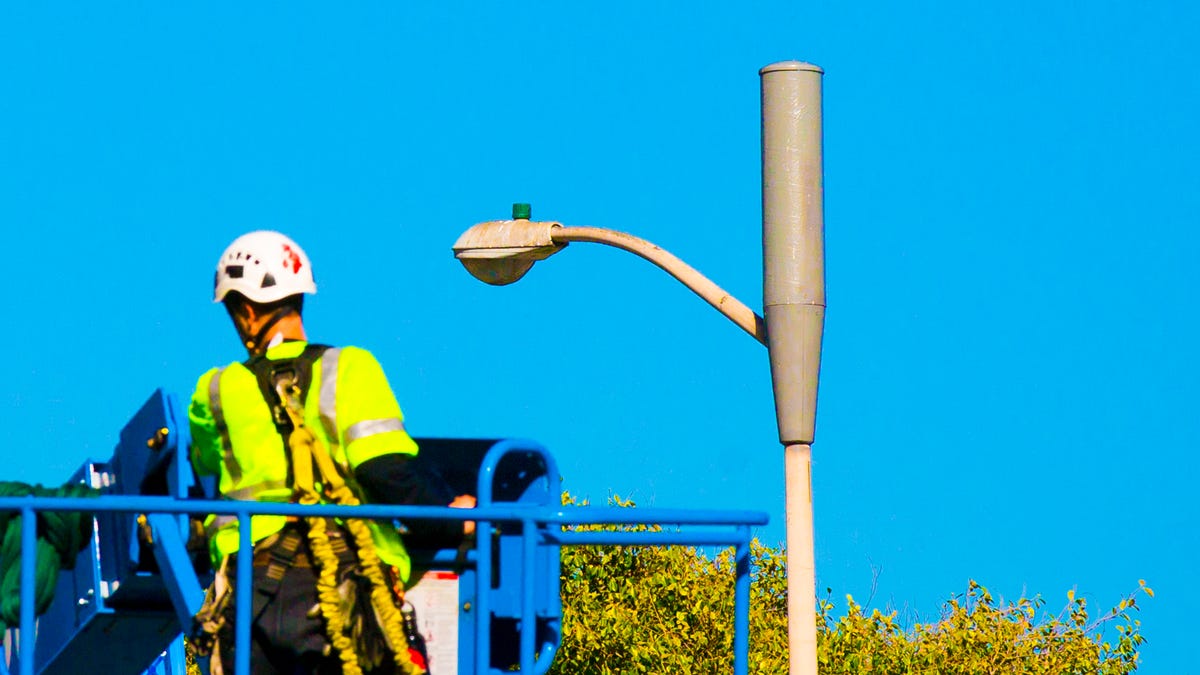Super Bowl's wireless blitz spurs carriers to brace for impact
Mobile operators have been preparing like mad to ensure that fans' selfies and video clips can be shared without a hitch.
Wireless operators have upgraded their networks across the San Francisco area to ensure they can handle mobile traffic during the weeklong Super Bowl 50 events.
James Martin/CNETFor millions of football fans around the world, the Super Bowl is the big game. For the four national wireless carriers, it is the big test.
Fans of the Carolina Panthers and Denver Broncos don't just care about their team's first touchdown on Sunday. They also value the selfies they send to social media while in the stadium. So for the wireless technicians and engineers who have been endlessly preparing for Super Bowl 50, the ultimate test of their network starts 30 minutes before the game when fans are streaming into the stadium and posting their reactions on Facebook and Instagram.
"They're energized taking pictures and sharing with everyone on social media," said John Cooke, assistant vice president for engineering radio access at AT&T.
This expected tsunami of data has prompted AT&T, Sprint, T-Mobile and Verizon to spend millions of dollars in preparation to ensure that their networks are rock solid on game day. Their performance is a big deal because the last thing any carrier wants is an embarrassing outage or slowdown at such a high-profile event.
The hunger for data keeps growing. Last year's Super Bowl in Phoenix saw 1.7 terabytes of data travel out of the stadium, the equivalent of 4.8 million social media posts with photos. The flood of photos and videos heading into the cloud via wireless Internet connections means that carriers must make extra preparations.
AT&T said it spent $100 million to upgrade its network in the Bay Area over the past year, with a quarter of that specifically for making sure its network is ready for Sunday. Verizon said it spent $70 million to get its network ready. Sprint and T-Mobile haven't disclosed specific amounts, but they each said they've been making network improvements.
"The usage patterns at the Super Bowl are very different from any other time on the network," Cooke said.
Pumped up
The first major upgrade was the distributed antenna system at Levi's Stadium in Santa Clara, California, which provides a mobile signal throughout the stands, suites, concourses and restaurants, as well as the surrounding tailgate area. More than 525 antennas and 60 miles of cable were added to the system, according to AT&T. The upgrades gave the antenna system the capacity of 25 traditional cellular sites, enough to cover a city the size of Santa Clara itself, the company said.
While the system is shared among the carriers, each operator tunes it to work best with its network. For instance, AT&T has made upgrades at the venue that it claims will offer its customers a 150 percent increase in LTE capacity over what was available at the start of the 2015 football season. T-Mobile said its upgrades to the antenna system will more than double the LTE capacity on its network from last year. It will also provide more reliable coverage in high-traffic areas throughout the concourses. Verizon said it has deployed for the first time a patented antenna system that it can use to reach the lower stadium seats.
Cells-on-wheels
Since many of the weeklong events leading up to the Super Bowl are happening 40 miles north in San Francisco, carriers have also upgraded their networks in that city and throughout the area. Some of these upgrades are permanent, such as the 75 small cell sites and 16 traditional larger cell sites that Verizon added in and around San Francisco.
AT&T also made permanent upgrades to its distributed antenna systems at 26 locations and built or upgraded 39 cell sites. T-Mobile, which recently made upgrades to its LTE network in the Bay Area, said it permanently added capacity to 150 cell sites serving 32 venues hosting events for the Super Bowl. Sprint, meanwhile, increased capacity at various sites in the region.
The carriers have also added temporary capacity around the Moscone Center in San Francisco, Levi's Stadium and surrounding airports and hotels. AT&T said it is deploying nine cells-on-wheels, or mobile cell sites, throughout the city and surrounding area. Sprint said it is sending out 11 of those mobile sites. Verizon and T-Mobile also have brought in cell towers on wheels to offer temporary capacity. And Verizon said it has a team of 100 technicians and engineers who will be on the ground to make sure things run smoothly.
All of this is happening to ensure that fans traveling from near and far don't experience hiccups in their mobile phone service.
"If it's a bad experience, it reflects on us, just like it does anytime people are frustrated with their service," AT&T's Cooke said. "The expectation is that you'll have service anywhere and everywhere. It's like oxygen."


